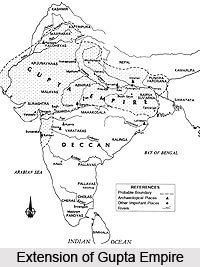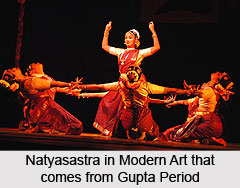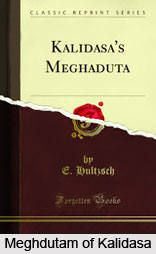 The literature under Gupta Empire became an important source of study of dramaturgy, poetry and literary theory in the later period. The famous Natyashastra of sage Narada dates back to the Gupta period. It is believed that Natyashastra though composed as early as the Gupta period, it served as catalectic foundation of dance, drama and music. All other forms of creative literatures reached the zenith of artistry during the reign of the Gupta rulers. The chief types of literary themes that were dealt with during this period were mainly erotic poetry and romantic comedies. Generally tragedies were avoided because the main purpose of the theatre was to entertain the audience.
The literature under Gupta Empire became an important source of study of dramaturgy, poetry and literary theory in the later period. The famous Natyashastra of sage Narada dates back to the Gupta period. It is believed that Natyashastra though composed as early as the Gupta period, it served as catalectic foundation of dance, drama and music. All other forms of creative literatures reached the zenith of artistry during the reign of the Gupta rulers. The chief types of literary themes that were dealt with during this period were mainly erotic poetry and romantic comedies. Generally tragedies were avoided because the main purpose of the theatre was to entertain the audience.
Narrative Literature
Indians have shown the greatest aptitude for narrative literature. The earliest of such stories were the Jatakas which has been translated into many European languages. They were written in Pali language with over a hundred tales. They contain tales and fables. It was part of Tantrakhya-yika or collection of little tales. The Panchatantra was a hand book of politics which gave advice to the princes in the form of tales told by animals. In the fables animals play the part of kings, ministers, courtiers, spies. The presentation is witty and gives very naturally some lesson of practical wisdom. One of the Indian versions of these fables is the Hitopadesha which was written in the 14th century. Panchatantra first went to Persia in the sixth century and then it was passed onto Arabia and Syria. From there the Greeks took it and later translations were made in Hebrew, Latin and Spanish. The earlier version of the Panchatantra was known as the Tantrakhyayika, which was most probably, composed in 250 A.D. It was so popular that about 200 versions of the book exist in more than 50 languages of the world. Its versions into Greek, Latin, Spanish, Italian, German, English and old Slavonic languages had come into existence before the close of the 16th century A.D.
 Among the literary stories we have Brihat-Katha by Gunadhya, narrating stories about king Udayana who is mentioned by Kalidasa in Meghaduta. Then there is Katha-sarit-sagara by Somadeva and Suka-Saptati. The story of Sindbad the Sailor seems to be of Indian origin. Among the romances mention may be made of those by Bana like the Harsha-Charita and Kadambari.
Among the literary stories we have Brihat-Katha by Gunadhya, narrating stories about king Udayana who is mentioned by Kalidasa in Meghaduta. Then there is Katha-sarit-sagara by Somadeva and Suka-Saptati. The story of Sindbad the Sailor seems to be of Indian origin. Among the romances mention may be made of those by Bana like the Harsha-Charita and Kadambari.
 Literature in Prakrit also flourished during the Gupta rule. Prakrit Literature was closely associated with the Jain texts. One of the famous pieces in Prakrit literature of the Gupta era was Paumacariyam by Vimalasuri. Its central theme was the story of Lord Rama as created by Sage Valmiki. It has presented a view point which is different from Valmiki and has made the epic a popular form of literature.
Literature in Prakrit also flourished during the Gupta rule. Prakrit Literature was closely associated with the Jain texts. One of the famous pieces in Prakrit literature of the Gupta era was Paumacariyam by Vimalasuri. Its central theme was the story of Lord Rama as created by Sage Valmiki. It has presented a view point which is different from Valmiki and has made the epic a popular form of literature.
Religious Literature
This age was famous for the final recons of works like the Gita, the Puranas and the Smritis. Popular Buddhist works belonging to the Mahayana school were written during this period. Lalita-vistara, Buddha-Charita by Asvaghosha who also wrote philosophical works like the Lankara Sutra and the Mahayana-sraddhotpada are the examples. Nagarjuna, another famous Buddhist, wrote Madhyamika defining and describing the doctrine of `Sunyata.` It was during this period that great philosophers composed the six systems of philosophies. Among other pieces of literature that can be mentioned is the Kama Sutra of Vatsayana.
It is believed that pieces of literature reached its zenith of glory during this period because the literary works dealt more with human behaviour than with religious ideas. Thus the way of expression became more realistic and beautiful because the emotions and ideas which were expressed through the prose, poems and plays were those which they could feel more closely to their heart.



















